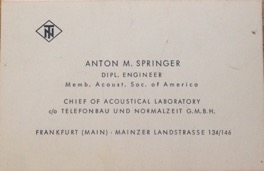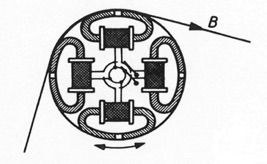Contributor Essays
Anton Springer and the Time and Pitch Regulator
by Fabian Voigtschild, Jonathan Sterne and Mara Mills
January 14, 2020
Since the beginnings of mechanical sound recording, playback rate and pitch were linked: increase the speed from the speed at which the sound was recorded and the pitch of the recording goes up; decrease the speed, the pitch goes down. This was true for cylinder, disc, film, wire, and tape playback. Yet there were many occasions where people wanted to play back a recording at a different rate than the one at which it was recorded without having the pitch change. Film operators discovered this problem with the advent of sync sound. Blind schoolchildren, who read by listening as well as Braille after Talking Books appeared in the 1930s, wanted to get their homework done faster. Communication engineers hypothesized that faster playback could save bandwidth in transmission and thereby multiply the carrying power of existing infrastructures.
One machine that attempted to solve this problem was Anton Marian Springer’s Acoustic Speed and Pitch Regulator (Tempo- und Tonlagenregler). As an attachment to a regular reel-to-reel tape machine, it used a rotating magnetic head to manipulate the two parameters of playback speed and pitch independently of each other. Springer’s path to the machine is lost to history. It may have come out of wartime research in Nazi-controlled firms, but might also have arisen in the postwar period. A 1950 patent based on Springer’s work aimed to condense messages at the source through a cathode ray tube-based system and re-expand them at the point of reception.
The speed and pitch regulator was first publicly demonstrated in 1953. Initial suggested uses included a dictation machine for secretaries and an aid for hard-of-hearing people, although these were both speculative. In practice, the regulator was most often employed in sound studios, for example to produce electroacoustic music, adjust radio programs to fit their assigned time slots and durations, or coordinate film music with images. Its technical descendants would later be used in advertising, speed listening for education, reading machines for blind users, and everyday sound editing. Although the first models only enabled time compression and expansion, subsequent versions included pitch-shifting capability. Springer’s rotating head principle also contributed to solving bandwidth problems for video tape, and the Ampex Corporation purchased a Springer machine in the research that led to their first commercial machinery for video recording and playback.
Anton Marian Springer was born on September 3, 1909, in Reichenberg, Bohemia (today’s Liberec, Czech Republic). He studied engineering for nine years at the German Technical University, Prague, before moving to Berlin to work in German radio. Under the Nazis, Springer was imprisoned for refusing to serve in the army, and according to his son Marian Anton “never held a gun in his life.” He was later released and put to work in communication engineering; his technical skills likely saved his life. After the war, he started his own business as an electrical engineer in the German town of Bad Homburg, and later spent several years in Frankfurt am Main as head of the acoustics lab at the company Telefonbau und Normalzeit (Figure 1).

From 1962 until his death in August 1964, Springer worked at Eltro GmbH in Heidelberg, heading the department of “information conversion” (Informationswandlung). He attracted international attention for his Acoustic Speed and Pitch Regulator, which he took with him when he moved to Heidelberg. Eltro marketed the machine worldwide as the “Tempophon”, the “Acoustic Time Regulator,” the “information rate changer,” and the “Springer machine.”
In the Acoustic Speed and Pitch Regulator, four small magnetic tape heads are attached to a rotating column, spaced at 90° intervals. The heads enable the tape’s playback speed to deviate from the recording speed such that playback rate can be changed without having to transform pitch. This principle was not invented by Springer; Eduard Schüller’s wartime magnetic tape recorder “Tonschreiber B,” for example, could modulate Morse code, slowing down playback to assist decoding. In Springer’s view, the great achievement of his own regulator was a technical extension that allowed even sustained signals such as speech or music to be manipulated with less distortion than in the Tonschreiber.
This analog modulation of playback speed is made possible by dividing the tape into modulation segments of around 40 ms each. Through trial and error, Springer selected the duration of each segment to be brief enough to render individual syllables or tones in an intelligible fashion, but long enough to avoid phase jumps in the signal. In practice, the machine left subtle audible artifacts in the sound, but they were often ignored until better hybrid analog/digital (and later, fully digital) alternatives emerged in the 1970s.
The length of the segments was based on the size of the rotating column and the space between the heads. The tape was fed across the head at an angle of 90°, so that it abutted only one of the four slots at any one time (Figure 2). To change the playback speed, segments had to be discarded or repeated in such a way as to maintain consistency of sound. If a recording was stretched, the newly created period had to be filled with redundant audio material; if it was compressed, existing acoustic information had to be reduced as inconspicuously as possible. By rotating the heads at a speed different from that of the tape, a section of tape could be played twice or skipped over. The modulation of pitch followed the same principle. Accelerating the tape speed resulted in a higher pitch, but the duration of the input signal and the original playback speed could be matched by repeating individual tape segments. A lower pitch resulted from slowing down the tape speed and leaving out short segments. Many of today’s digital time-stretching and pitch-shifting tools make use of this principle in their operation.

Springer presented a prototype of his speed and pitch regulator to the public at the first International Congress on Acoustics, held in Delft in 1953. He also participated several times in the Gravesano meetings, arranged by Hermann Scherchen for members of the musical and technological avant-garde to discuss issues at the intersection of music, acoustics, and electroacoustics. Scherchen edited the journal Gravesaner Blätter/Gravesano Review, hosted the meetings in Gravesano, directed the Gravesano Experimental Studios (where many of the journal’s gramophone supplements were produced), and was one of the most celebrated conductors of his day. Thanks to his contact with Scherchen, Springer was able to publish some of his papers on information transfer in Gravesaner Blätter. Other contributors to the journal included Iannis Xenakis, Friedrich Trautwein, Pierre Boulez, Fritz Winckel, and Theodor W. Adorno. Springer’s device wound up in many of the now-canonical studios of mid-century Western Europe, and influenced ideas about time and sound in the writings of Xenakis, Karlheinz Stockhausen, Pierre Schaffer, and others. In the United States, it found broadcasting, educational, military, forensic, and musical applications.
A few examples of Springer’s Acoustic Speed and Pitch Regulator survive, held in the Berlin musicological institute Staatliches Institut für Musikforschung, the Oskar Sala collection at the Deutsches Museum in Munich, the WDR broadcaster’s Studio for Electronic Music in Cologne, the Musikinstrumenten-Museum in Berlin, the Rai Studio of Phonology in Milan, the University of California-San Diego, and possibly the Institute of Sonology in The Hague. We do not know if any of these machines are in working condition.
With the kind help of Springer’s son Marian Anton Springer, we were able to assemble and digitize for the “Sound & Science: Digital Histories” database an extensive collection of material on the Acoustic Speed and Pitch Regulator and on Springer’s biography from his private papers. The collection includes photographs, documents such as Springer’s contract with Eltro GmbH and an original patent document from the United States, and fourteen gramophone records owned by Springer, most of them published as supplements to Gravesaner Blätter. There are also three tapes with recordings made by Springer himself—two of experiments on the Acoustic Speed and Pitch Regulator, and one of Springer reading out a text on electronic information transfer and storage—as well as eight offprints of articles on information conversion and transfer that Springer published between 1953 and 1963 in the journals Umschau, Funkschau, Frequenz, Electronische Rundschau, and Laryngologie, Rhinologie, Otologie und ihre Grenzgebiete. The collection is rounded off by four tape recordings of Springer’s spoken contributions at the Gravesano Conference in August 1961, provided by the Hermann-Scherchen-Archiv of the Akademie der Künste, Berlin.
By Fabian Voigtschild, Jonathan Sterne, and Mara Mills
Mara Mills and Jonathan Sterne are currently finishing a monograph, Tuning Time: Histories of Sound and Speed, with a chapter on Springer’s Time and Pitch Regulator. Hints on further historical speed-regulating technologies are always welcome: ac.lligcm@enrets.nahtanoj; ude.uyn@sllimm





